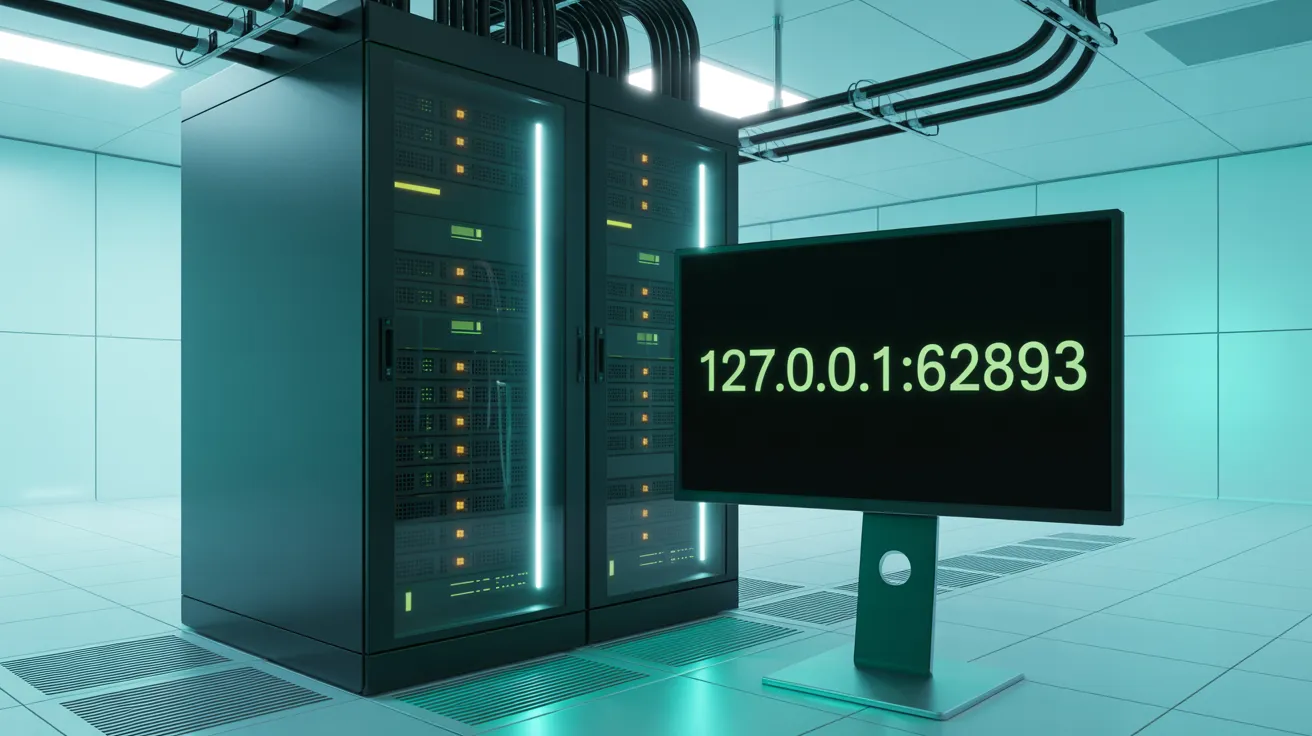Table of Contents
When you think of computer networks, a few common terms immediately come to mind: IP addresses, servers, ports, and protocols.
But what happens when you encounter something like 127.0.0.1:62893? It might seem cryptic at first glance, but once you break it down, you’ll realize it’s all about networking and testing, particularly on your local machine.
In this blog, we’ll explore the meaning of 127.0.0.1, the significance of port numbers like 62893, and how this combination works in computer networking.
Whether you’re an aspiring programmer, IT enthusiast, or just curious about the digital world, this guide will help you understand these concepts in simple terms.
What Is 127.0.0.1? The Localhost IP Address?

The IP address 127.0.0.1 is one of the most commonly used in the world of networking. It’s known as the loopback address, and it refers to the localhost or your own computer.
When you type 127.0.0.1 into a web browser or a command line interface, you’re essentially talking to your own machine, not going out to the internet.
Here’s why it’s important:
- Self-Testing: Developers often use 127.0.0.1 to test web servers or applications locally, ensuring everything works before making it available on the internet. It’s a way to simulate a live environment without needing an actual server.
- Communication with Network Services: It’s also used for software that needs to communicate with itself. For instance, applications like databases or web servers may connect to the loopback address to fetch data or respond to requests without leaving the machine.
- System Diagnostics: IT professionals often use 127.0.0.1 as a diagnostic tool. Pinging 127.0.0.1 can verify whether a network card or the TCP/IP stack is working properly on your machine.
What is the Significance of Port Numbers like 62893?
When you combine 127.0.0.1 with a port number, like 62893, you’re referring to a specific process or service running on your computer. Ports are numerical values used by network protocols to identify specific applications or services.
Each port number is assigned to a specific type of communication:
- Well-known Ports (0-1023) are used by widely known services like HTTP (port 80), FTP (port 21), and HTTPS (port 443).
- Registered Ports (1024-49151) are used by applications that aren’t as widely recognized but still need to communicate over the network.
- Dynamic/Private Ports (49152-65535) are used by client-side applications for temporary connections.
In your example, 62893 would likely refer to a dynamic port used by a specific service on your local machine. This could be anything from a local web server, a database server, or a custom application running on your computer.
Read also: SOA OS23
Breaking Down 127.0.0.1:62893
Now that we know what both 127.0.0.1 and 62893 represent individually, let’s break down how they work together.
The Role of Localhost
127.0.0.1 points to your own machine, so when you see an address like 127.0.0.1:62893, it’s telling you that a service is running locally. In other words, your computer is acting as both the server and the client.
Port 62893 – An Open Door
Port 62893 is like a door where a specific service is waiting for data. This port could be associated with a particular application on your computer. If you connect to 127.0.0.1:62893, you’re sending data to that specific application on your machine.
For example, if you’re running a local web server for testing purposes, you might access it through 127.0.0.1:62893. The server will listen on this port and respond to any requests you send its way.
Why You Need Ports for Communication?
Ports are necessary for directing traffic within your system. Your computer might have dozens of services running at the same time, such as web servers, databases, or email clients.
Each of these services listens on a specific port to differentiate the types of communication they handle. Without ports, it would be impossible for your computer to know where to direct the data.
How Developers Use 127.0.0.1:62893?
As a developer, you’re likely to encounter combinations like 127.0.0.1:62893 often. Here’s why they matter in your daily workflow:
Local Development and Testing
When building a web application, you need a way to test it before making it public. Local development environments often use 127.0.0.1 as a placeholder for an actual server. For instance:
- Web Servers: You might have a local Apache or Nginx server running on port 62893. Typing 127.0.0.1:62893 in your browser will load the web page hosted on your local machine.
- Databases: If you’re using databases like MySQL or MongoDB locally, they often listen on specific ports. You would connect to the database using something like 127.0.0.1:3306 for MySQL or 127.0.0.1:27017 for MongoDB.
Troubleshooting and Debugging
The 127.0.0.1 address is also an important tool for troubleshooting. Developers often use it to test if their applications are running correctly locally. If you’re trying to debug an issue with an application not loading, checking if it’s accessible via 127.0.0.1:62893 can help you determine whether the problem is local or external.
Virtual Networking for Testing
In complex development setups, developers may use virtual machines or containers (such as Docker) for isolated environments. These setups also make use of the 127.0.0.1 address to communicate between the host machine and virtual instances, often using different ports.
Common Issues with 127.0.0.1:62893
Although 127.0.0.1:62893 and similar local addresses are incredibly useful, there are some common issues that users encounter.
Port Conflicts
If two services are trying to use the same port on your machine, they can’t both operate properly. This is called a port conflict.
For example, if your web server is already using port 62893 but you try to run another service on the same port, the second service will fail to connect. The solution is to either change the port number or stop the conflicting service.
Firewall Blockages
Sometimes, firewalls on your computer or network may block certain ports from being accessed. If you’re having trouble connecting to 127.0.0.1:62893, it’s worth checking your firewall settings to ensure the port is open for communication.
Service Not Running
Another common issue is that the service you’re trying to reach isn’t running on the expected port. If you try accessing 127.0.0.1:62893 but there’s no service listening on that port, you’ll get an error or timeout message.
In such cases, ensure the application you’re trying to access is properly running and listening on that port.
Security Considerations for Using 127.0.0.1
While 127.0.0.1 is typically a safe address, it’s still important to keep security in mind. Although it connects only to your machine, vulnerabilities in the software listening on local ports can still be exploited.
Here are some security best practices to follow:
- Limit Port Access: Use firewalls to restrict access to ports like 62893 if you’re working in a shared environment or using a server that may be exposed to the internet.
- Keep Software Updated: Ensure the services running on your machine are up-to-date to avoid security holes.
- Use Strong Authentication: If your application uses ports to communicate with databases or other services, ensure strong authentication is implemented to prevent unauthorized access.
Final words
In conclusion, 127.0.0.1:62893 represents a local networking address and a specific port number, often used by developers to test or run applications on their own machine.
Understanding how 127.0.0.1 and port numbers work together can greatly help with troubleshooting, development, and secure communication between applications on your local machine.
Whether you’re building websites, databases, or running custom applications, this loopback address is an essential tool for many tasks.
By understanding this seemingly simple concept, you open up a world of possibilities for local development, debugging, and testing, which is the foundation of creating fully functional, live applications.
People also ask
What is the loopback address 127.0.0.1 used for?
The loopback address 127.0.0.1 is used to refer to your own computer in networking. It’s often used for testing, troubleshooting, and running services locally without needing an external server.
How do I know which ports are open on my machine?
You can use tools like netstat or lsof (on Unix-based systems) or netstat -an on Windows to check which ports are open and what services are listening on them.
Can I change the port number?
Yes, you can change the port number in the configuration files of most services you are running, such as web servers, databases, or local applications.
Why can’t I connect to 127.0.0.1:62893?
If you’re unable to connect to this address, ensure that the service you’re trying to connect to is running and listening on that port. You may also need to check your firewall settings.
Is 127.0.0.1 secure?
While 127.0.0.1 is typically safe since it only connects to your machine, ensure that the services running on it are secured with proper authentication and encryption.

